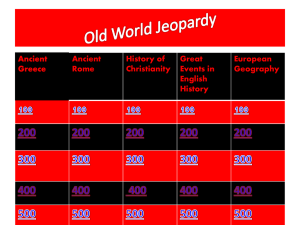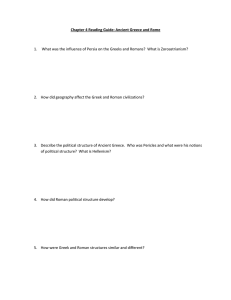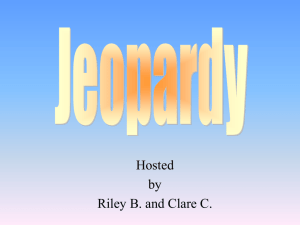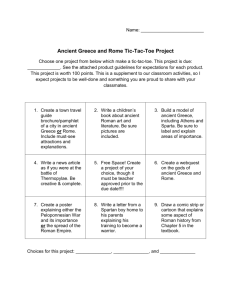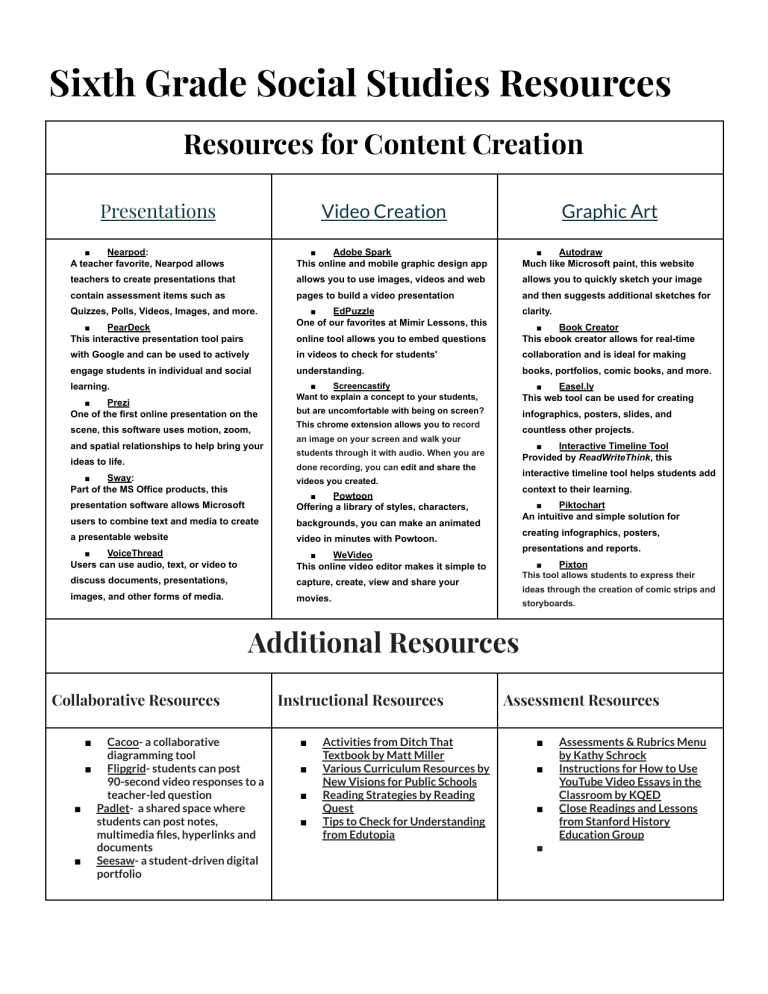
Sixth Grade Social Studies Resources Resources for Content Creation Presentations Video Creation Graphic Art Nearpod: ■ A teacher favorite, Nearpod allows Adobe Spark ■ This online and mobile graphic design app Autodraw ■ Much like Microsoft paint, this website teachers to create presentations that allows you to use images, videos and web allows you to quickly sketch your image contain assessment items such as pages to build a video presentation and then suggests additional sketches for Quizzes, Polls, Videos, Images, and more. EdPuzzle One of our favorites at Mimir Lessons, this clarity. PearDeck This interactive presentation tool pairs ■ online tool allows you to embed questions Book Creator ■ This ebook creator allows for real-time with Google and can be used to actively in videos to check for students' collaboration and is ideal for making engage students in individual and social understanding. books, portfolios, comic books, and more. learning. ■ Screencastify Want to explain a concept to your students, Easel.ly ■ This web tool can be used for creating but are uncomfortable with being on screen? infographics, posters, slides, and ■ Prezi One of the first online presentation on the ■ scene, this software uses motion, zoom, and spatial relationships to help bring your ideas to life. This chrome extension allows you to record countless other projects. an image on your screen and walk your Interactive Timeline Tool ■ Provided by ReadWriteThink, this students through it with audio. When you are done recording, you can edit and share the Sway: Part of the MS Office products, this ■ interactive timeline tool helps students add videos you created. presentation software allows Microsoft Powtoon ■ Offering a library of styles, characters, users to combine text and media to create backgrounds, you can make an animated a presentable website video in minutes with Powtoon. VoiceThread Users can use audio, text, or video to WeVideo This online video editor makes it simple to discuss documents, presentations, capture, create, view and share your images, and other forms of media. movies. ■ context to their learning. Piktochart ■ An intuitive and simple solution for creating infographics, posters, presentations and reports. ■ Pixton ■ This tool allows students to express their ideas through the creation of comic strips and storyboards. Additional Resources Collaborative Resources Cacoo- a collaborative diagramming tool ■ Flipgrid- students can post 90-second video responses to a teacher-led question ■ Padlet- a shared space where students can post notes, multimedia files, hyperlinks and documents ■ Seesaw- a student-driven digital portfolio ■ Instructional Resources ■ ■ ■ ■ Activities from Ditch That Textbook by Matt Miller Various Curriculum Resources by New Visions for Public Schools Reading Strategies by Reading Quest Tips to Check for Understanding from Edutopia Assessment Resources ■ ■ ■ ■ Assessments & Rubrics Menu by Kathy Schrock Instructions for How to Use YouTube Video Essays in the Classroom by KQED Close Readings and Lessons from Stanford History Education Group Unit Planning Resources Quarter One Unit Learning Targets Planning Resources ■ Foundations of Human Civilization (c. 10,000-3500 BCE) Great Rivers I can name the designations for time dating by creating a timeline vertically and horizontally using BC, BCE, AD, and CE, and order events of the past. of Great I can define the designations for time dating, including circa, decade, century, and millennial (millennium). (AZ State I can name which time designations are secular and religious. Geoalliance) I can identify the characteristics of the nomadic hunter-gatherer (Paleolithic) society, including their use of: ● basic hunting weapons ● fire ● shelter ● other tools I can define the Agricultural Revolution (Neolithic) and cite examples of the impact farming had on societies, including: ● development of a barter economy ● domestication of plants and animals ● emergence of permanent settlements ● food surpluses ● labor specialization ● new sources of clothing and shelter I can identify the basic components of civilization and explain how they contribute to the development out of a primitive state, including: ● culture ● government ● religion ● social structure ● stable food supply ● technology ● writing Civilizations ■ Ancient Civilizations Amusement Park ■ Creating Culture Wheels (AZ State Geoalliance) ■ Global Issues-Perfor mance Assessment PDF (Center for Global Education) Ancient Mesopotamia (c. 3500-1700 BCE) I can show and map geographic features surrounding ancient Mesopotamia, including: ● Black Sea ● Euphrates River ● Mediterranean Sea ● Persian Gulf ● Tigris River ● Zagros Mountains ■ Mesopotamia: Project History Teacher (menu of options) I can summarize how the geography and climate led to the region referred to as the Fertile Crescent. I can describe the effects of different inventions and systems that helped to develop advancements in agriculture including irrigation, silt, metallurgy, production of tools, use of plants and animals, slave labor, and inventions (the wheel, sail, and plow). I can create a sequence to show the agricultural advancements in Sumer and explain the effects of each, including economic growth, expansion of trade and transportation, and the emergence of independent city-states. I can define the basic concepts that make up a monarchy and empire and name Mesopotamia as the location of the world’s first sustained empire. I can define polytheism. I can cite evidence of the beliefs about the relationship of deities in the natural world and their importance in everyday life in Mesopotamia. I can identify the important achievements of Mesopotamian civilization including the development of cuneiform, clay tablets, and ziggurats. I can name the Epic of Gilgamesh as the oldest written epic. I can cite textual evidence to show the introduction of the rule of law, presumption of innocence, and a modern take on judicial procedure (e.g. provide evidence/witnesses in a dispute) in the Code of Hammurabi. I can also show how these Code of Hammurabi principles are reflected in the U.S. Constitution. Federal Mandate 36 U.S. Code ■ Ancient Israel (c. 2000-500 BCE) I can show and map geographic features of ancient Israel, including: Israel: Ancient Israel Project-Activit ● ● ● ● ● ● Dead Sea Jerusalem Jordan River Mediterranean Sea Red Sea Sinai Peninsula I can map the migrations of the ancient Israelites and explain the reasons they moved from Mesopotamia to Canaan, from Canaan to Egypt, and from Egypt back to Canaan (later called Israel). I can identify the roles of Abraham and Moses and describe their contributions in developing the Hebrews into a nation of people later referred to as Israelites. I can cite textual evidence from The Tanakh (Hebrew Bible) to describe the central features of Judaism, including: ● monotheism ● the Ten Commandments ● individual worth and personal responsibility I can compare the roles and major contributions of the kings of Israel, including: ● Saul as the first king ● David, second king, founded Jerusalem as the capital ● Solomon, third king, built the first Temple I can outline key events that led to the breakup of Israel into two kingdoms: Israel (Northern Kingdom) and Judah (Southern Kingdom), including: ● destruction of the Northern Kingdom (by Assyria) ● people of Judah become known as the Jews ● Babylonian captivity under Nebuchadnezzar II (New Babylon) ● Jews return to their homeland under Persian Empire I can summarize what led to the capture of the Jewish people and the outcome of their time spent in Babylonian captivity. I can describe what led to the return of the Jews to their homeland under the Persian Empire and explain the impact on the ancient Jews, including: ● destruction of the first Temple ● the end of Babylonian captivity ● Cyrus the Great granting permission for the Jews to return ● the rebuilding of the second Temple in Jerusalem y Menu Quarter Two Unit Learning Targets Planning Resources ■ Egypt: Ancient Egypt (c. 3000-700 BCE) I can find and map geographical features surrounding ancient Egypt, including: ● the Mediterranean Sea ● Nile Delta ● Nile River ● Red Sea, ● Upper and Lower Egypt ● as well as the Sahara. I can recognize and explain why Egyptians settled along the Nile River and the connection to the geographic terms of Upper and Lower Egypt. I can outline the agricultural practices used in ancient Egypt and describe the impact on life and economic growth, including the use of irrigation and the development of a calendar. I can create a visual representation and use it to describe the structure of Egyptian society, including: ● ● ● ● relationships between groups of people, how the classes were organized by occupation, positions of pharaohs as gods/kings the role of enslaved people I can identify the ancient Egyptian religion and describe: ● ● ● their beliefs about the afterlife reasons for mummification the use of pyramids by citing evidence from informational texts. I can explain the impact of key Egyptian figures including: ● Queen Hatshepsut and her economic policies ● Ramses the Great’s military conquests ● significance of the discovery of Tutankhamun's tomb on the understanding of ancient Egypt (Valley of the Kings) I can examine and recognize ancient Egyptian artifacts and identify the lasting impact of these ancient achievements had on Egyptian civilizations, including: ● hieroglyphics ● papyrus ● the pyramids and Sphinx at Giza Illustrated Children's Book (HTH) ■ Egypt: Unit-Final Project PDF (Project Tahoe) I can define cultural diffusion and summarize changes within and outside of ancient Egypt that resulted from cultural diffusion with surrounding civilizations through trade and conflict. Ancient India (c. 2500-400 BCE) I can show and map geographical features surrounding ancient India, including the Ganges and Indus River, Himalayan Mountains, Indian Ocean, monsoon winds, and the subcontinent of India. I can explain how the Harappan civilization emerged in the Indus River Valley as an early agricultural civilization. I can describe the achievements of the Harappan civilizations, including architecture built with bricks, arranging roads into a series of grid-systems, sanitation, and sewer systems. I can create a visual representation of the social structure of ancient India and explain the effect the caste system had on everyday life. I can identify the origins of Aryan traditions and explain the influence they had on central features of Hinduism. I can identify the central teachings of The Vedas and summarize the key features of Hinduism which came from this sacred text. I can define dharma, karma, reincarnation, and moksha, and identify their role to Hinduism. I can create a narrative description of the life of Siddhartha Gautama (Buddha) and explain the influence his teachings had on central features of Buddhism. I can identify the role of the Tripiṭaka for a Buddhist: ● rules for monks (discipline) ● teachings and meditation techniques ● songs and stories from the Buddha’s life (higher knowledge) I can summarize the Four Noble Truths and Eightfold beliefs and identify their importance. I can explain the important ideas and achievements of the late empire of ancient India, including medical education, medical techniques, and mathematics, and describe the long-lasting impact. Quarter Three Unit Ancient China (c. 2500 BCE-200 CE) Learning Targets I can identify and map geographical features surrounding ancient China, including the Gobi Desert, Himalayan Mountains, Pacific Ocean, Plateau of Tibet, Yangtze, and Yellow Rivers. I can identify and explain why the geography in the region led ancient Chinese civilizations to settle in the Yellow River Valley during the era of the Shang Dynasty. I can recognize which geographic features of China contributed to its isolation from the rest of the world and explain the consequences of this isolation. I can examine the geographic features of China to infer challenges of governing a region of this size in ancient times and find evidence to support my claim. I can compare the concepts of the Mandate of Heaven and Legalism and explain their purpose related to governing in ancient China. I can name the political and cultural problems present in society at the time of Confucius. I can cite textual evidence from the philosophy of Confucianism and excerpts from The Analects, including the concepts of kinship, order, and hierarchy to address the political and cultural problems throughout China at this time. I can organize the significant policies and achievements of the emperor Qin Shi Huangdi into one coherent narrative or timeline. I can describe the impact Qin Shi Huangdi’s achievements and the construction of the Great Wall had in the unification of ancient China during the Qin Dynasty. I can show the role of Confucianism in contributing to the long-term political success of the Han Dynasty. I can describe the technological advances made in ancient China during the Han Dynasty, including: the magnetic compass, paper making, porcelain, silk, and woodblock printing. I can explain the impact of the demand for Chinese goods and cite evidence to support the significance of The Silk Road, and how it resulted in cultural diffusion throughout Eurasia, including the introduction of Buddhism into ancient Planning Resources ■ China: Celebration of the Silk Road China during the Han Dynasty. I can find types of Chinese artifacts by pictorial representation and recognize its influence on objects present today. ■ Ancient Greece (c. 800-300 BCE) I can show and map geographical features surrounding ancient Greece, including Asia Minor, Athens, Macedonia, Mediterranean Sea, Peloponnesian Peninsula, and Sparta. Athens & Sparta-Project I can recognize and describe how the geography in the region led civilizations of ancient Greece to organize into city-states and contributed to its role and methods in maritime trade and colonization throughout the Mediterranean. History Teacher (menu of I can define the concept of the polis and explain the role of citizenship and civic participation in ancient Greek city-states. I can define the rule of law and distinguish its purpose. options) ■ Greece ■ I can describe the political structures of direct democracy and oligarchy. Project History Teacher (menu of options) ■ I can identify the polytheistic religion of ancient Greece and Greece: Early Mycenaeans- I can compare life in Athens and Sparta, including: ● advantages of each geographic location ● approaches to education ● practice of slavery ● status of women ● styles of government I can identify the causes and effects of the Peloponnesian Wars and explain how the growing political conflict between Athens and Sparta led to war and left city-states open to conquest by the Macedonians (Philip II). Greece: Digging Up I can relate the characteristics of Greek democracy which influenced the future of the United States system of government. I can explain the causes, course, and consequences of the Persian invasions of Greece, including: ● Ionian Revolt ● rise of Athens ● Battle of Marathon ● 300 Spartans ● Peloponnesian and Delian Leagues ● Persian and Greek leaders ● Battles of Thermopylae and Salamis ● Battle of Plataea Greece: Greece: Greek Mythology Puppet Show (Utah Edu Network) ■ Greece: Newspaper Project (PBS) describe the myths and stories, giving examples of humanlike qualities of Greek gods, goddesses, and heroes including Zeus, Hermes, Aphrodite, Athena, Poseidon, Artemis, Hades, and Apollo. ■ Greece & Rome: Inquiry Unit I can cite examples of Greek gods/goddesses' names and humanlike qualities as part of our everyday use and culture (such as Midas touch, Herculean strength, FTD florist, Nike swoosh). I can compare the Titans with the Olympian gods and explain the Greek mythology. I can summarize the tradition of the Olympic Games and cite evidence to explain why the Olympics were established, and which sports they featured. I can identify the development of the alphabet (Phoenician, Greek, and Latin). I can describe the importance and cite textual evidence to support the impact ancient literature had in shaping Greek culture, including: ● The Iliad ● The Odyssey ● Aesop’s Fables I can compare the philosophies of Aristotle, Plato, and Socrates and state their influence in shaping Greek culture. I can explain the purpose and function of Greek architecture, including the Parthenon and the Acropolis. I can create a timeline to sequence the events that led to the unification of the Greek city-states by Macedonia. I can analyze the causes and effects of Hellenistic culture, including the spread and breakup of Alexander’s empire. I can show Greek artifacts by pictorial representation and recognize its influence on objects present today. Quarter Four Unit Ancient Rome (c. 500 BCE-500 CE) Learning Targets I can identify and map geographical features surrounding ancient Rome, including: ● Constantinople ● Italian AlpsItalian Peninsula ● Mediterranean Sea ● Rome ● Tiber River Planning Resources ■ Rome: Mythology Talk Show (Use discretion as the Roman gods & goddesses information and I can show the significance of the Tiber River and seven hills in shaping Roman society and explain how the geographic location of Rome contributed to its political and economic power in the Mediterranean region and beyond. I can create a visual representation and use it to explain the governmental structure and guiding principles of the Roman Republic, including: ● branches of government ● checks and balances ● civic participation ● representative democracy (Republic) ● the rule of law and the Twelve Tablets images may not be appropriate for your students) ■ Build Rome in a Day - 3D Class Project ■ Greco-Roman Day Project Idea ■ Inquiry: How I can name the class and gender divisions and create a visual representation to explain the social structure of ancient Rome, including the role of patricians, plebeians, and enslaved people.. Have the I can identify how Julius Caesar’s influence on leadership in the military led to the transition from a Roman Republic to an empire. Rome I can explain Julius Caesar’s popularity amongst plebeians and how it influenced his ability to become a permanent dictator. US Govt? I can analyze the tone of documents written about Caesar's assassination to explain the impact of his life. Tahoe) I can explain the growth of the Roman Empire under Augustus Caesars, including the use of currency and trade routes during the Pax Romana. I can explain the importance of engineering and architectural advances that led to Roman expansion, including: ● aqueducts ● arches ● bridges ● The Colosseum ● domes ● roads ● sanitation I can identify challenges and changes that resulted from major engineering and architectural developments of ancient Rome and its influence on today’s architecture. I can name the religion of ancient Rome and cite evidence to describe the beliefs about the humanlike qualities of the deities as well as their importance in everyday life. Governments of Greece & Influenced the PDF (Project I can match the Roman gods and goddesses with those from Greek mythology, including: ● Jupiter – Zeus ● Mercury – Hermes ● Venus – Aphrodite ● Mars – Ares ● Neptune – Poseidon ● Saturn – Cronus ● Pluto – Hades ● Juno -- Hera I can show examples of how Roman mythology is present in our everyday lives (e.g. planetary names, calendar, etc.). I can identify the origins and summarize the core beliefs of Christianity including: ● monotheism ● Jesus as the Messiah and His life and teachings ● the life, teachings, and contributions of Paul to Gentiles ● the belief in The Bible ● the concept of sin and forgiveness ● eternal life in heaven I can describe how Judaism survived the expulsion/scattering of the Jews to other lands (Jewish Diaspora) and describe its effects on Judaism. I can create a timeline to sequence the noteworthy events that led to division of the Roman Empire into East and West. I can describe the significance of the city of Constantinople being established as the capital by Constantine and its location. I can identify reasons and major events that led to the decline of the Roman Empire, including the influence of important leaders. I can identify and explain the causes and effects of the fall of the Western Roman Empire, including: ● difficulty governing its large territory ● political corruption ● economic instability ● attacks by Germanic tribes ● continuation of the Eastern Roman Empire as the Byzantine I can show Roman artifacts by pictorial representation and recognize its influence on objects present today.

